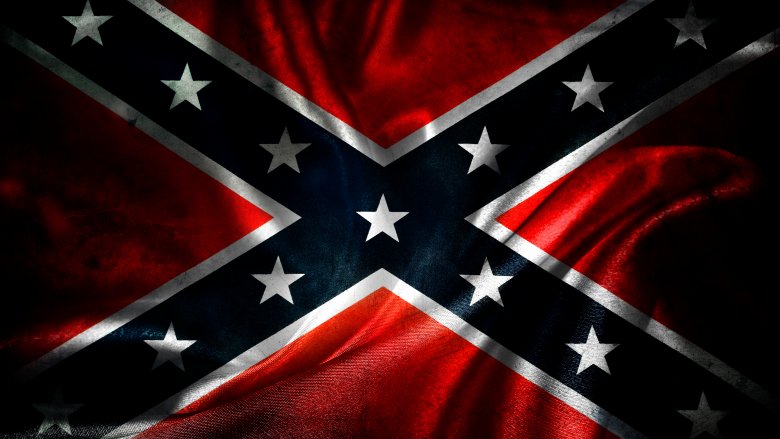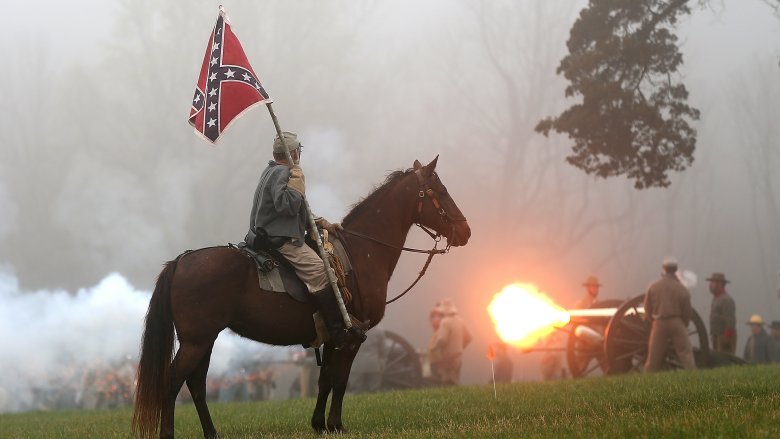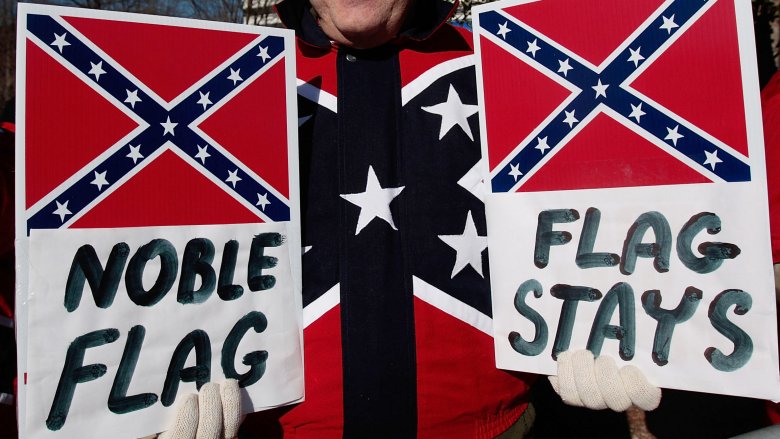The Real Meaning Of The Confederate Flag
Remember when country singer Brad Paisley and rapper/actor LL Cool J teamed up for "Accidental Racist?" The song opens by describing a scenario in which Paisley feels like a Starbucks barista pegs him as a racist for wearing a Lynyrd Skynyrd t-shirt featuring the Confederate flag. Speaking with Guitar World, the singer revealed that this wasn't a wholly fictional depiction: "I was called a racist once for wearing an Alabama T-shirt. That really opened my eyes. Am I really a racist for wearing that shirt?"
At the heart of Paisley's question is the distinction between the intended message and what others perceive when someone displays a Confederate flag. Some people proudly tout it as a symbol of southern heritage while others condemn it as a celebration of racism, slavery, and treason. However, the American Civil War Museum points out that "the Heritage versus Hate slogan war is a false dichotomy. There's no reason why the Confederate flag cannot stand for both heritage and hate, or stand for a myriad of things other than heritage or hate."
Obviously, it would be absurd to pretend we know what goes through the mind of every single person who's brandished a Confederate flag. After all, not everyone made a song to clarify that they're just a Skynyrd fan. As with all forms of speech, explicit and implicit, context is crucial to interpreting what the Confederate flag has generally meant to groups who used it throughout U.S. history.
What the Confederate flag meant during the Civil War
Let's begin with the Civil War. As noted by John Coski, author of "The Confederate Battle Flag: America's Most Embattled Emblem," the flag we now associate with the Confederacy — which features a "star-studded blue cross" against a red background — began as a battle flag for Virginia's Confederate army. The first flag to represent the secessionist states as a whole was known as the "Stars and Bars" and strongly resembled the United States flag. This understandably fostered confusion on the battlefield, which was exacerbated by the use of different battle flags by different regiments.
By 1863, the Confederacy incorporated Virginia's battlefield banner in a new national flag, the so-called "Stainless Banner," which featured the blue cross with red background in the upper left corner of a field of white. Okay, so that flag helped distinguish the United States from those which wished to divide the States. But what did it actually stand for? In the context of the Civil War its "meaning" is inextricably linked to what the Confederacy stood for.
Citing the declarations of secession by South Carolina, Mississippi, Florida, Alabama, Louisiana, and Texas, the Atlantic observes that the central reason for seceding from the Union was the desire to preserve slavery. Jefferson Davis, the president of the Confederacy, believed that "white men have an equality resulting from a presence of a lower caste, which cannot exist where white men fill the position here occupied by the servile race." The Confederacy specifically sought to defend the secessionist states' perceived right to own slaves, and the Confederate president maintained that keeping black people in bondage enshrined white supremacy. So it seems fair to say that by extension, the Confederate flag was steeped in those beliefs.
What the Confederate flag has meant since
In the early aftermath of the Civil War the flag became an emblem that memorialized fallen Confederate soldiers and was eventually embraced as a symbol of the South in general. In 1948, a political contingent dubbed the "Dixiecrats" seceded from the Democratic party after Democrats embraced a platform of civil rights for blacks. The Dixiecrats adopted the Confederate flag as a way to protest civil rights and support Jim Crow segregation. During the 1930s and '40s the Ku Klux Klan also adopted the flag. Understandably, many people see it as a symbol of that ugly history.


